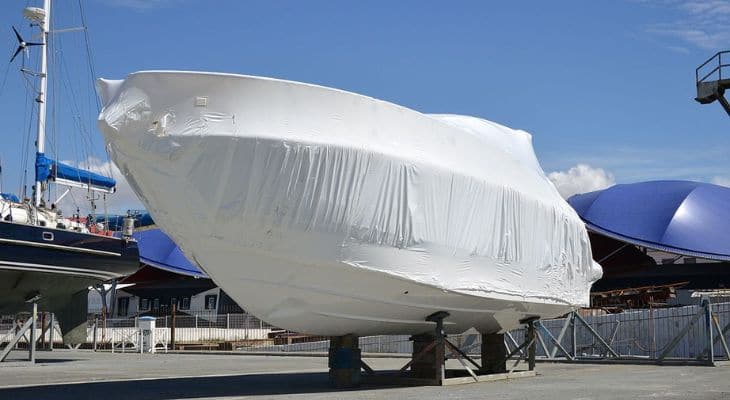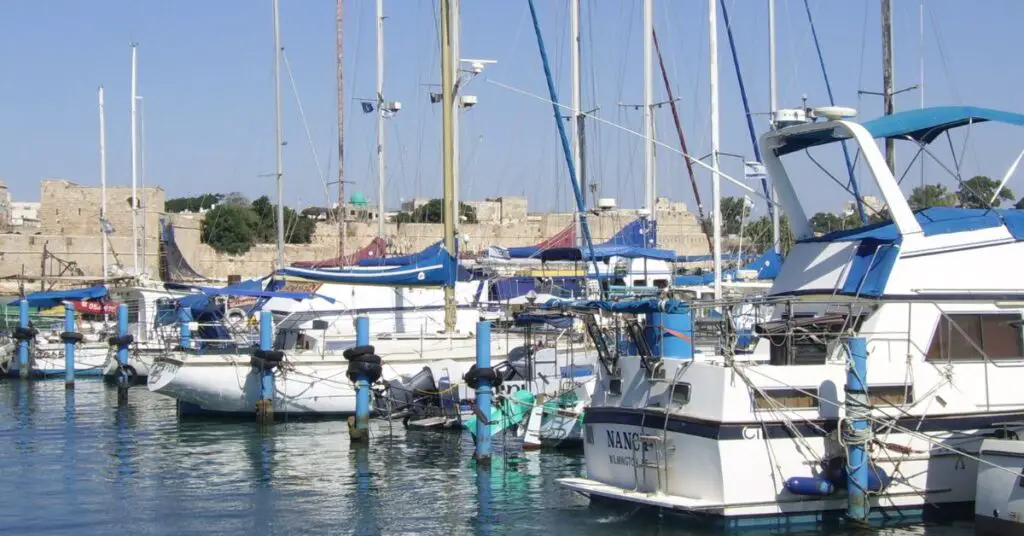Depending on how and where you store your boat, the price can change. For example, a high-cost-of-living city such as Los Angeles, California will probably charge more for the same type of boat storage than a city like Housten, Texas. Along with that, if you store your boat in a heated indoor garage, it will cost more than an outdoor boat parking lot.
However, after calculating the costs of each type of storage in 15 different US cities, here is how much boat storage costs on average:
It costs around $8-$18 per foot of your boat per month to store your boat in an indoor garage, and $4-$10 per foot per month for outdoor storage. Some marinas may also let you store your boat in the water all season (known as wet storage) for about $6-$12 per foot per month.
Note: Warm weather states wet storage rates may be higher due to year-round demand.
Here is a table of the 15 US cities I used to determine these numbers and how much storage costs in each of those cities:
| City | Indoor (per foot per month) | Outdoor Dry (per foot per month) | Wet storage (per foot per month) |
|---|---|---|---|
| Baltimore, MD | $12 | $6 | $7 |
| Boston, MA | $18 | $10 | $8 |
| Chicago, IL | $11 | $5 | NA |
| Corpus Christi, TX | $14 | $8 | $13 |
| Detroit, MI | $8 | $5 | $8 |
| Housten, TX | $8 | $7 | $9 |
| Jacksonville, FL | $13 | $9 | $11 |
| Los Angeles, CA | $15 | $12 | $20 |
| Miami, FL | $12 | $9 | $18 |
| New Orleans, LA | $10 | $7 | $9 |
| San Diego, CA | $16 | $10 | $20 |
| San Fransisco, CA | $16 | $9 | $15 |
| Seattle, WA | $16 | $9 | $17 |
| St. Louis, MO | $8 | $5 | $8 |
| Tampa, FL | $13 | $8 | $13 |
Things to consider
Nicer facilities and facilities in prime locations will cost more. Some popular boating cities with high living costs such as Miami and Los Angeles will cost more than most of America for boat storage even if the facilities are not as nice.
Also, having boat storage in a prime location in a specific city (such as a marina) will usually cost more than a non-prime location.
Sometimes paying for nice indoor storage will save you money because keeping your boat out in the elements can damage your boat, which may be expensive to fix. At the very least, you should always get your boat shrink-wrapped if you’re leaving it in outside storage.
Indoor storage
Most expensive option

Indoor boat storage generally costs around $8-$18 per foot of your boat per month. This makes it the most expensive option. However, it is by far the best for protecting your boat and allowing you to easily access it during the wintertime as you generally won’t have to cover it.
Many boat storage garages allow you to walk in and work on your boat as needed. However, this is not possible if your boat is stored outside and is shrink-wrapped, and it is not very easy if your boat is left in the water when it’s freezing cold outside.
Dad Tip: if you get a heated garage spot, you can always go relax on your boat to get some free time to yourself.
Many indoor facilities are located right next to marinas that will handle getting your boat out of the water and putting it into storage for you. They generally also offer other services such as winterizing, waxing, cleaning, oil changes, and many more.
Outdoor storage
Cheapest option

It only costs around $4 to $10 per foot per month to store your boat outdoors. This means this will be the cheapest option for most boaters. However, It’s cheaper for a reason as you will not be able to do much work on your boat when it’s in storage, and you need to shrink-wrap it to avoid it getting damaged by the environment.
Shrink-wrapping will cost around $200-$400, and it may not even fully protect it. Hurricanes, tornados, or any other storm could easily damage your boat if it’s kept in outdoor storage. Especially if it’s on a boat rack.
Along with that, theft and engine cracking due to lack of winterizing are much more likely to happen to boats stored outside. So you may want to purchase year-round boat insurance, which could bring up the total cost another couple hundred dollars.
So although outdoor boat storage may be cheap, it has some downsides that need to be considered. However, even if you were to purchase year-round insurance, shrink-wrapping, and a winterizing service, it will still be just under half as expensive to store your boat outside compared to indoors.
In-water storage
Best for people who use their boats all-season long

In-water storage costs around $6-$12 per foot per month. Depending on where you are from, year-round in-water storage could be very cheap. However, in those areas, it’s cheap for a reason. Northern states get cold and many times freeze over the winter
This is why I generally recommend year-round storage for southern states where you can boat all year round. However, it is possible in northern states, you will just need to make sure your marina allows it, and you properly prepare.
The benefit of in-water storage is you don’t have to deal with lifting your boat out of the water, moving it to storage, paying for storage, and then putting it back in the water at the end of the off-season. Along with that, you can usually extend your boating season longer. So most people who do this have large vessels.
Your boat will need to be properly winterized and covered, and you will need a de-icing system of some sort to avoid structural damage to your boat. Check out this article to learn more.
Other possible storage types
Although the storage types above are the most popular, that doesn’t mean you have to store your boat that way. Instead, you could do this:
At-home garage storage
If you can convince your family, having your boat at home is the best possible solution to boat storage. Not only is working on your boat super easy, but you’ll also have the freedom to move it whenever you would like. Many large indoor facilities only release your boat on certain dates.
Driveway outdoor storage
This method may also require you to do some convincing, but storing your boat in your driveway could be a possible option if nothing else works. Of course, you will need to lock up the trailer properly and probably have a camera watching it. You could also extend your insurance to an all-year plan to protect against theft.
Mooring storage
A mooring is an anchor in the water (generally in coves and small bays) that you can connect your boat to and leave it. These are usually much cheaper than marinas, but there are many cons involved with them. They are very susceptible to damage from bad weather, it’s hard to get to your boat, and there are no electrical connections and no fresh water connections.
What are some other expenses associated with boat storage
Besides just storing your boat, you’ll need to pay for or do many things to prepare your boat for the off-season. These include:
- Winterizing – $300-$600
- Annual Maintenance check – $500 – thousands if something is broken
- Washing – $100-$200
- Pulling your boat out of the water – $150-$400
- Putting your boat back in the water – $150-$400
- Shrink-wrapping (for outdoor storage) – $200-$400
How to save money when storing your boat
Luckily, there are many things you can do to save money when storing your boat. However, most of these will still cost time, so it depends on how much you value your time. Nevertheless, these are the best things you can due to save money on boat storage:
- Shop around to find the best storage price. Many times just by storing your boat in a smaller city just 50 miles away from home, you could save hundreds of dollars per month. So make sure you visit all the storage facilities in your area and beyond to find a good deal.
- Do preparations yourself. If you are a reasonably handy person, learning how to winterize or shrink-wrap your boat is a pretty simple thing to do. Additionally, many of the maintenance tasks such as taking out the batteries and changing the oil can also be done by you for much cheaper than hiring someone.
- Store your boat at home. As I was talking about in the alternate storage options sub-heading, storing your boat at home is one of the most cost-efficient ways to do it. However, this may take some convincing as your family may not like the idea of having a big ugly boat blocking the driveway or clogging the garage all winter.
- What Is The Cheapest Way To Store A Boat? - February 28, 2023
- Do Boats Need Bottom Paint? (Uncovering the Truth) - February 2, 2023
- How Much Is Bass Boat Insurance? (Real Quotes) - January 18, 2023

